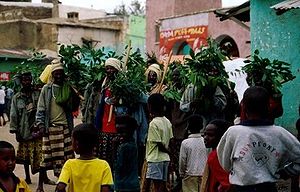Rainmaking


Rainmaking is a weather modification ritual that attempts to invoke rain.
Among the best known examples of weather modification rituals are North American rain dances, historically performed by many Native American tribes, particularly in the Southwestern United States. Some of these weather modification rituals are still implemented today.[1]
Examples
North America
Julia M. Buttree (the wife of Ernest Thompson Seton) describes the rain dance of the Zuni, along with other Native American dances, in her book The Rhythm of the Redman.[2][3] Feathers and turquoise, or other blue items, are worn during the ceremony to symbolize wind and rain respectively. Details on how best to perform the Rain Dance have been passed down by oral tradition.[4] In an early sort of meteorology, Native Americans in the midwestern parts of the modern United States often tracked and followed known weather patterns while offering to perform a rain dance for settlers in return for trade items. This is best documented among the Osage and Quapaw Indian tribes of Missouri and Arkansas.[citation needed]
Africa
Rain is a central concern of African societies which depend on it for their sustenance and that of their animals. The power to make rain is usually attributed to African kings. In a number of African societies, kings who failed to produce the expected rain ran the risk of being blamed as scapegoats and killed by their people.[5] A famous rain making monarch is the Rain Queen of Balobedu, South Africa.
Tribal rain dances are done to ensure rain comes. Notable peoples known to have done rain dances are tribes on the Sahara Desert and Ethiopia.
China
Wu shamans in ancient China performed sacrificial rain dance ceremonies in times of drought. Wu anciently served as intermediaries with nature spirits believed to control rainfall and flooding.[6] "Shamans had to carry out an exhausting dance within a ring of fire until, sweating profusely, the falling drops of perspirations produced the desired rain."[7]
Thailand
Rain is important for agriculturists, since they want water for growing plants. When the rain doesn't fall in a season, people use traditional means of making rain to solve the problem of the lack of rainfall. In Thailand, there is a tradition called the "Cat Parade".[8]
The "Cat Parade" is a ritual of Thai farmers in both the central and eastern parts of the country. It is performed when close to the rainy season, if the rain hasn't come. Farmers will often join the "Cat Parade". The ancients believed that the cat is an animal which is afraid of rain and water. If it rained, the cat would cry. The ancients considered that if the cat cries it means that rain is going to fall. Some people believe that the cat represents drought. If the cat is wet, the drought will be driven away. Others believed that the cat has the power to make rain.[9]
To perform a "Cat Parade", you must bring a female cat that has grey or black fur. The cats are then to be placed in baskets; only one cat should be put in a basket. You must then walk around in the village. When the "Cat Parade" goes through someone's house, that person needs to splash water on the cats. It is believed that rain would then fall after three to seven days.
Europe
Caloian, Dodola and Perperuna / Paparuda, among other terms, refer to a family of Slavic and Romanian rainmaking rituals, some of which survived into the 20th century.[citation needed]
See also
References
- ↑ "Rain Dance". Indians.org. American Indian Heritage Foundation. Retrieved 4 September 2011.
- ↑ Julia M. Buttree (Julia M. Seton) The Rhythm of the Redman: in Song, Dance and Decoration. New York, A.S. Barnes, 1930.
- ↑ "Rain Dance of Zuni". Inquiry.net. 2013-07-03. Retrieved 2014-03-05.
- ↑ "The rain dance helped native Americans get through dry summers". Indians.org. Retrieved 2014-03-05.
- ↑ Simonse, Simon. 1992. Kings of Disaster: Dualism, Centralism and the Scapegoat King in Southeastern Sudan. Brill. Lw
- ↑ Schafer, Edward H. 1951. "Ritual Exposure in Ancient China", Harvard Journal of Asiatic Studies 14:130-184.
- ↑ Unschuld, Paul U. 1985. Medicine in China: A History of Ideas. University of California Press. pp 33-34.
- ↑ ไตรรงค์ ปิมปา ("Tricolor Pimpa"). "ประเพณีแห่นางแมว อ้อนวอนขอฝน ("Cat parade praying for rain")".
- ↑ "Cat parade", http://orawan123.blogspot.com/2013/02/blog-post.html